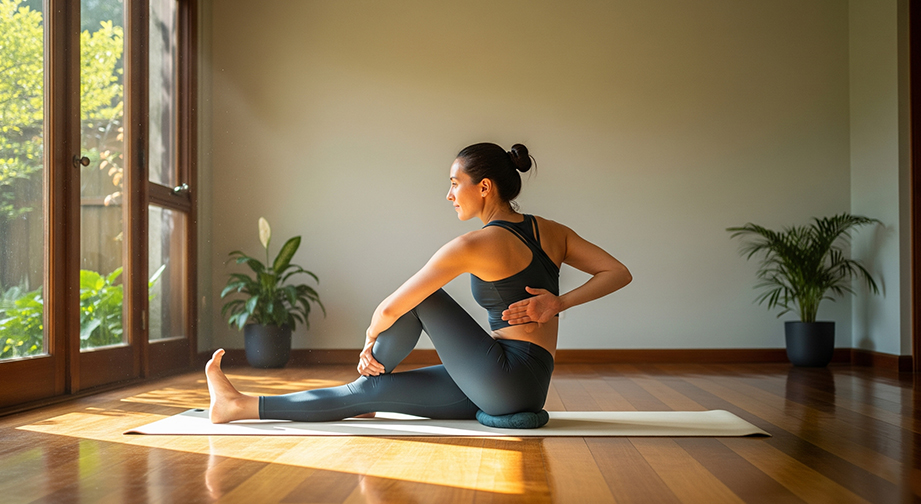Marichyasana (Marichi’s Pose): Step-by-Step Guide, Benefits, Tips & More
Introduction
Marichyasana, also known as Marichi’s Pose (pronounced mah-ree-chee-AHS-uh-nuh), is a seated yoga asana that stretches your back, shoulders, and hips. The Sanskrit name comes from “Marichi,” meaning "ray of light," and “asana,” meaning "pose." At its essence, Marichyasana is a calming and centering posture that helps bring mindful awareness to your body and breath.
If you’ve ever felt stiff after sitting too long—or just need a gentle twist and stretch—this pose can be your best friend. It’s accessible for beginners, requires minimal space, and can work wonders for tight backs and restless minds.
Step-by-Step Guide

- Start Seated: Sit on the floor with your legs extended straight in front of you (Staff Pose/Dandasana). Keep your spine long and shoulders relaxed.
- Bend One Knee: Bend your right knee and place the right foot flat on the floor, a few inches away from your right sit bone. Your left leg stays extended.
- Inhale: Lengthen your spine, reaching the crown of your head up.
- Exhale: Hug your right knee with your left arm, or (for a more advanced variation) wrap the left arm around your shin and reach the right hand behind you for a gentle twist.
- Keep Your Chest Open: Inhale and broaden across your collarbones, growing taller with each breath.
- Breathe & Hold: Take slow breaths—inhale to lengthen the spine, exhale to gently twist deeper. Stay here for 5–8 breaths, then release and switch sides.
How Long: Hold each side for 30–60 seconds (about 5–8 breaths), repeat 1–2 rounds per side.
Modifications for Beginners
- Sit on a folded blanket if your hips are tight.
- Hug your knee with your arm rather than trying a bind.
- Use a yoga strap around your bent knee and holding hand for a gentle stretch.
For Advanced Practitioners
- Try Marichyasana C: Bind by reaching your left arm around your bent knee and clasp your right hand behind your back.
- Deepen the twist on each exhale, maintaining length in your spine.
Alignment & Safety Tips
- Keep your sitting bones grounded and your extended leg active (toes flexed).
- Twist from your upper back, not your lower back.
- Shoulders relaxed, chest open.
- Avoid rounding or collapsing your spine forward.
- Breathe steadily—never hold your breath in the twist.
Common Mistakes
- Collapsing the chest—focus on staying upright.
- Lifting the extended leg—keep it grounded and active.
- Over-rotating the lower back—instead, twist from the rib cage.
Safety Precautions
- Avoid if you’re pregnant (especially deep twists).
- Skip or modify if you have recent back, hip, or knee injuries.
- Always listen to your body—stop if you feel pain (stretching: okay; pain: stop).
Benefits of Marichyasana (Marichi’s Pose)
Physical Benefits
- Improves spinal flexibility and mobility
- Stretches the shoulders, hips, and hamstrings
- Strengthens the core and back muscles
- Stimulates digestion and massages abdominal organs
- Helps to improve posture
Mental Benefits
- Soothes the nervous system
- Relieves stress and mental fatigue
- Encourages mindfulness and present-moment awareness
Energy/Chakra Connection
- Activates and balances the Manipura (solar plexus chakra), supporting confidence and inner strength
- Clears energetic stagnation from the abdominal center
Contraindications
- Pregnant individuals (especially in later stages)—avoid deep twists.
- If you have a herniated disc or severe spinal injury, skip or modify this posture.
- Those with recent surgery in hips, knees, or abdomen should avoid Marichyasana pose or consult a yoga therapist.
Alternatives:
- Seated Forward Fold (Paschimottanasana)
- Simple Seated Twist (without binding or deep rotation)
Beginner’s Tips & Variations
Using Props
- Yoga Block/Bolster: Sit on it to elevate your hips for easier alignment.
- Strap: Place around bent knee for a gentle bind.
- Wall: Rest your back hand on a wall for support during the twist.
Gentle Variations
- Simply hug your knee and focus on spinal length rather than a full twist.
Advanced Variations
- Full bind (clasping hands behind your back).
- Add a forward fold over your extended leg for an additional hamstring stretch.
How to Include Marichyasana in Your Yoga Flow
- When: Works well as a main practice or in the cool-down phase—after hip openers or before relaxation.
- Pairs Well With:
- Janu Sirsasana (Head-to-Knee Forward Bend)
- Baddha Konasana (Bound Angle Pose)
- Paschimottanasana (Seated Forward Fold)
Mind-Body Connection
Practicing Marichyasana invites you to tune in, quiet your thoughts, and focus on the rhythm of your breath. The gentle twist not only nourishes the body but also helps release emotional and mental tension, creating space for clarity and calm. As Marichi means "ray of light," let this pose be a moment to invite brightness and mindfulness into your practice.
Asana Name: Marichyasana (Marichi’s Pose)
Level: Beginner to Intermediate
Focus Areas: Spine, Hips, Shoulders, Core
Duration: 30–60 seconds each side (1–2 rounds)
Best Time to Practice: Morning or Evening
Frequently Asked Questions
1. Can I practice Marichyasana every day?
Yes, if you have no injuries. It’s a gentle pose that can help unlock stiffness and keep your spine mobile.
2. Do I need to be flexible to try Marichi’s Pose?
No! Props and modifications make Marichyasana accessible for all levels.
3. What should I do if my back or hips hurt in this pose?
Practice a gentler twist, use props, or consult with a yoga teacher for personalized adjustments. Never force the twist.